
Introduction
Kartagener Syndrome is a rare genetic condition that affects the body’s ability to move mucus and fluids through the respiratory system, causing damage to various organs. In specific, it is known to impair the functionality of cilia, which are hair-like structures found in many of the body’s organs. Understanding the role of cilia in the body can provide insight into the root causes of Kartagener Syndrome and potential treatment options. In this article, we will explore the organelle most impacted by Kartagener Syndrome and its functions in the body.
Understanding the Role of Cilia
Cilia are microscopic, hair-like organelles that are present on the surface of cells throughout the body. They serve multiple functions, including moving fluid, clearing respiratory passages, and sensing the environment. Cilia function best when they move in unison, creating a sweeping motion to move mucus and other fluids through the respiratory system and other organs.
When cilia are not functioning properly, the body may struggle to clear mucus and fluids, leading to a buildup of congestion and, in some cases, serious infections. Research shows that cilia dysfunction has also been linked to numerous genetic conditions, including primary ciliary dyskinesia (PCD) and Kartagener Syndrome.
Decoding Kartagener Syndrome
Kartagener Syndrome, is a genetic disorder in which cilia dysfunction leads to various symptoms. Kartagener Syndrome is associated with several symptoms, including bronchiectasis (lung disease), chronic sinusitis, and infertility. The syndrome is associated with a genetic mutation that negatively affects the proper formation of cilia, resulting in their inability to function correctly.
The Cilia Connection
Cilia are significantly disrupted in Kartagener Syndrom,, where the cilia are immobile or have very little movement. This leads to a buildup of mucus and fluid in the respiratory system and other organs, resulting in the various associated conditions associated with Kartagener Syndrome.
The malfunctioning cilia can also impact the body’s ability to respond to stress appropriately. Therefore, even relatively benign infections can present severe health risks for patients with Kartagener Syndrome.
Examining the Impaired Organelle in Kartagener Syndrome
Cilia are the impaired organelle in Kartagener Syndrome. They perform critical functions in various parts of the body, including in the respiratory system, the brain, and reproductive organs.
When Kartagener Syndrome occurs, the cilia fail to function appropriately, reducing their effectiveness at moving fluids and matter through the body.
Kartagener Syndrome: A Spotlight on the Damaged Organelle and its Functions
The cilia play multiple critical roles in the body, including clearing the lungs, powering the movement of eggs in the female reproductive system, and enabling the development of the left-right asymmetry system in the early stages of embryonic development.
Dysfunctional cilia can interrupt these functions and lead to various health problems, including infertility, lung damage, and physical malformations.
Revealing the Mystery of Kartagener Syndrome: Focus on the Organelle
Researchers have been studying Kartagener Syndrome for many years, striving to understand better how impaired cilia functions lead to associated health problems. Recent findings indicate that correcting cilia dysfunction can help treat the root cause of Kartagener Syndrome.
New therapies, including gene editing and targeted treatment of cilia abnormalities, offer hope for individuals living with Kartagener Syndrome. These therapies aim to address the root cause of the disease and repair damaged cilia functions.
Why Cilia Matters: An Overview of Organelle Dysfunction in Kartagener Syndrome
Because cilia are responsible for so many essential functions in the body, their malfunction can lead to many health problems. Additionally, the discovery of specific genetic mutations associated with Kartagener Syndrome highlights the essential role that cilia play in many processes, including organ development, physiology, and reproductive processes.
Ultimately, research into the cilia’s role in Kartagener Syndrome can lead to new treatment options and a better understanding of how these organelles contribute to overall health and well-being.
Conclusion
As we have explored in this article, Kartagener Syndrome is a complex genetic condition that results in cilia dysfunction. Understanding the role of cilia in the body is critical when it comes to understanding the root cause of this disease and the potential for new treatments. Although there is currently no cure for Kartagener Syndrome, advances in medical research are bringing us closer every day. As we continue to learn more about the complex interactions between cells and organs, cutting-edge therapies offer hope for a better tomorrow.




